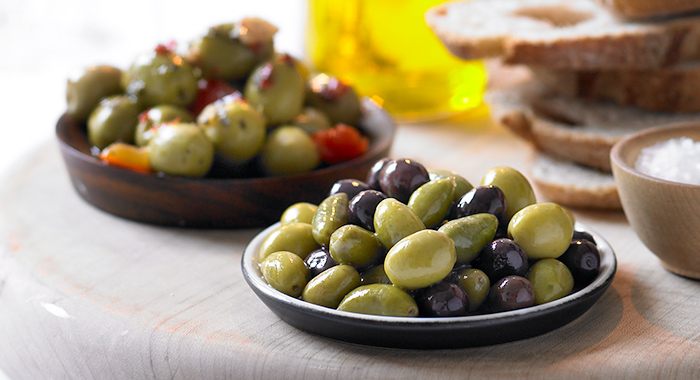
Pronounce it: ol-liv
Widely grown all over the Mediterranean, where they’ve been cultivated since biblical times, olives are mainly green and black, but can also come in many different shades in between.
The difference in colour reflects not their variety, but the stage of ripening when picked. Green olives are harvested in October or November, when still young. Black olives are picked in December, by which time they have matured and are fully ripe.
Most of the crop is used to make olive oil, and the remainder is preserved by pickling, marinading or sometimes salting, to be eaten as they are or used in cooking.
Availability
All year round.
Choose the best
The flavour of cured olives varies considerably. The best tend to be sold loose – which also allows you to try the different flavours before you buy.
In general, green olives are the plumpest and firmest, with a sharper taste. Good varieties to look out for include juicy Queen or smaller Manzanilla olives, both from Spain, or the Italian Cerignola.
As black olives have been given longer to ripen, they have a higher oil content, which gives them a milder flavour and softer texture. Look for glossy skins and, for maximum flavour impact, a small size and slight wrinkling – Italian Gaeta olives and those from Liguria are especially good.
The ink black olives that tend to be tinned in brine are usually green olives that have been dyed – their flavour is nothing in comparison to the real thing.
Kalamata olives come from the town of the same name in Greece they are large, with a purple tinge and a fruity flavour and considered to be the best in the country.
Olives can also be stuffed with flavourings such as nuts, lemon rind, capers, anchovies and peppers. As they’re firmer and have a sharper taste, larger green olives, such as those from Apulia and Sicily in Italy, tend to be the candidates for stuffing. Avoid buying pitted olives, as their flavour is inferior.
Prepare it
Drain the oil of brine that they’ve been stored in, then pit, if you like (you can buy pitters for this task). Leave whole or chop, according to your recipe.
Store it
Tinned or bottled olives should be stored in a cool, dark place until opened. They’ll last up to 12 months. After opening, keep in the fridge in an airtight container – they keep for 3-4 days.
Olives bought loose should also be kept in an airtight container and consumed within the same length of time.
Cook it
Serve stuffed olives with drinks; use to make tapenade; chop and add to salads, pasta, or stews, or use to top pizza.
Be the first to comment on "Olive"